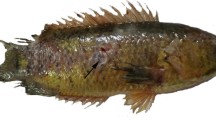Abstract
Distribution of injectedVibrio anguillarum in body ofPenaeus monodon was studied with immunohistochemical method. Bacteria could be detected throughout the experiment in some individuals: however in lymphoid tissue, gill, heart and haemolymph of all vibrio injected shrimp, the bacteria could be observed only 5 min after injection. The bacteria density in haemolymph, haemolymph of the hepatopancreas and gills decreased with time. In the lymphoid organ and heart, the bacteria density was the highest 48 h after injection, then decreased. Nodules could be formed in the heart, lymphoid organ and injection site.
Similar content being viewed by others
References
Ding, M. L., L. Lin, G. Y. Li et al., 1997. Effects of organic pollution onPeneaus chinesis body’s intraenvironment and externalenvironment.Oceanol. Limnol. Sin. 28(1): 7–12. (in Chinese)
Itami, T., Y. Takashi, Y. Nakamura, 1989. Efficacy of vaccination against vibriosis in cultured kuruma prawnsPenaeus japonicus.Journal of Aquatic Animal Health 1: 238–242.
Johnson, P. T. 1987. A review of fixed phagocytic and pinocytotic cells of decapod crustaceans, with remarks on haemocytes.Developmental and comparative immunology,11: 607–704.
Kondo, M., T. Itami, R. Takahashi et al., 1996. Ultrastuctrual and cytochemical characterization of phagocytes in kuruma,Penaeus japonicus. The second international conference on the culture of penaeid prawns and shrimps, 14–17 May 1996, Ililo City, Philippines.
Lightner, D. V., R. M. Redman, 1998. Shrimp diseases and current diagnostic methods.Aquaculture 164, 201–220.
Liu, W. S., 1999. Haemocyte characteristic and activity of the haemotopoietic tissue in shrimp,Penaeus monodon, after lipopolysaccharide injection. MSc Thesis in Fish Culture.
Rengpipa, S., S. Rukpratanporn, S. Piyatiratitivorakul et al., 2000. Immunity enhancement in black tiger shrimp (Peneaus monodon) by a probiont bacterium (Bacillus S11).Aquaculture 191: 271–288.
Smith, V. J., 1986. Cellular immune mechanisms in the crustacea.Symp. Zool. soc. Lond. 56: 59–79.
Söderhäll, K., M. W. Johansson, V. J. Smith, 1988. Internal defense Mechanisms. (In: D. M. Holdich and R. S. Lowery, ed, Freshwater Crayfish: Biology, Management and Exploitation, Timber Press, Portland, Oregon: 213–235.
Sritunyalucksana, K., P. Sithisarn, B. Withayachumnarnkul et al., 1999. Activation of prophenoloxidase, agglutinin and antibacterial activity in haemolymph of the black tiger prawn,Peneaus monodon, by immunostimulants.Fish & Shellfish Immunology 9: 21–30.
Sung, H. H., Y. L. Song, 1996. Tissue location ofVibrio antigen delivered by immersion to tiger shrimp (Penaeus monodon).Aquaculture 145: 41–54.
Wang, L., G. Y. Li, Y. X. Mao, 1995. Measuring methods and variations of some haemolymph factors in Penaeus chinensis after their oral ingestion of immuno-drugs.Oceanol. Limnol. Sin. 26(1): 34–41. (in Chinese).
Author information
Authors and Affiliations
Additional information
This work was funded partly by “Science Funds Program of the Chinese Academy of Fishery Science Research” (No.: 2001-2-5).
Rights and permissions
About this article
Cite this article
Zhixun, G., vande Braak, K. & Botterbloom, M. Distribution of bacteria injected in body of giant black shrimp,Penaeus monodon . Chin. J. Ocean. Limnol. 22, 186–191 (2004). https://doi.org/10.1007/BF02842591
Received:
Accepted:
Issue Date:
DOI: https://doi.org/10.1007/BF02842591




